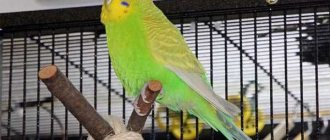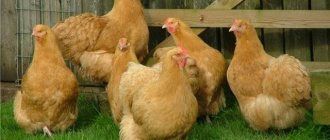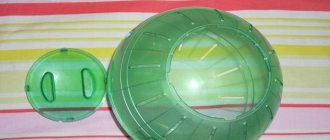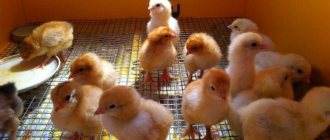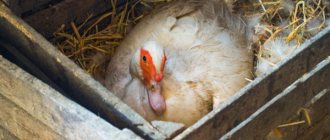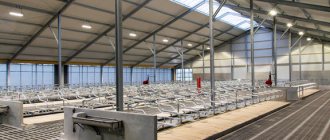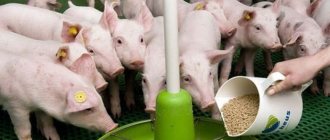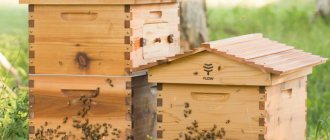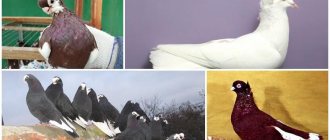Keeping a pigeon in an apartment
Keeping pigeons in a city apartment is an exotic, but very popular method of breeding.
The main difficulty is maintaining cleanliness inside the premises, as well as ensuring that birds can freely go outside (Figure 4). If you are interested in how to keep a pigeon in an apartment, we recommend that you read the tips in the sections below.
Content Features
To keep pigeons in an apartment, you need to properly arrange the place of residence.
The most important thing is a spacious and bright cage with clean air. An excellent option would be if your apartment is on the top floor with an attic
For ease of cleaning, it is better to make the bedding in the cage out of paper. Also in the cage there should be a feeder, a drinking bowl, a wooden perch and a bath (Figure 5).
For the health of pigeons, they need not only good living conditions, but also proper nutrition.
Therefore, it is very important to provide birds with nutritious food. The food must contain all the nutrients: fats, proteins, carbohydrates and vitamins. Don’t forget about water, it is the key to good digestion and muscle function.
Proteins are needed for the formation and development of bird organs, plumage growth and egg formation. In addition to the main food, vitamins are given.
Figure 4. Features of living in a city apartment
Vitamins are especially needed during the period of molting and growth, as well as when hatching or feeding chicks.
The basis for the feed is a grain mixture, small pebbles and mineral feed. Greens, vegetables, and boiled porridge are given as additional food. But under no circumstances should pigeons be given salty foods or black bread.
Content Rules
If you decide to keep pigeons in an apartment, then you need to adhere to the rules of optimal housing and feeding.
The key features of keeping a pigeon are:
- housing should be bright and spacious;
- nutritious food;
- There should be no drafts in the room;
- Do not give birds food that contains excrement;
- you need to constantly change the water;
- the cage should be washed once a week with detergent;
- the litter is changed twice a week or when soiled;
- You cannot use cotton wool or rags as bedding;
- For bathing, pigeons need to be provided with a container of water.
Figure 5. Drawing and photo of cages for keeping pigeons at home
Once a day, the bird should be released to fly around the apartment. In this case, safety precautions must be observed. Take the animals out of the room, curtain the windows and mirrors so that the bird does not break.
Kingi pigeons: breeding
Representatives of the King breed are unpretentious in terms of housing and food. Due to their heavy weight, nests for them are placed on the floor or on small hills, so that they can be reached along a perch (Figure 4).
In addition, King pigeons can be bred in outdoor enclosures or in special cages in a city apartment.
Peculiarities
Females and males of this breed are good parents; they incubate eggs on their own and take care of the chicks. For mating, females who are one year old or more are selected. During the incubation period, you need to examine the eggs with an ovoscope to determine whether the embryo is developing.
Figure 4. External features of King pigeons
The female produces two eggs per clutch. In winter, you need to install artificial lighting to increase productivity. On average, one pair can produce up to 20 chicks during its life.
Newborn pigeons feed on “crop milk”. After 6 weeks they begin to eat food on their own. Experienced pigeon breeders claim that a month after birth, the chicks are ready for sale.
Bird categories
All captive-bred pigeons can be divided into 3 separate categories:
- Decorative look. These representatives have an unusual plumage color and exterior. There are about two hundred species of such birds and about 30 different colors. Their disadvantage is that special conditions for keeping decorative pigeons are required.
- Flying pigeons. Each variety has its own individual flight pattern. Therefore, breeding flying pigeons attracts more people who like to watch the flight of birds.
- Sporty look. These birds are descendants of homing pigeons. They are usually bred to participate in tournaments to identify the fastest individual.
Some prefer dietary meat, for which pigeons are bred. Outwardly, it resembles game meat, but has a delicate sweetish taste. It is sometimes combined with fruits or berries.
Proper poultry nutrition
What to feed pigeons at home? For the health of birds, their diet should be balanced and nutritious. The nutritional diet is determined based on the breed of pigeon, as well as the purpose of breeding the bird. For the subsequent sale of poultry meat, feeding will differ significantly from usual.
It is important to consider at what time feeding takes place. The main thing is to set a specific time for this
The daily menu of pigeons should include wheat, corn, and vegetables.
In summer, give food three times a day, in winter, twice. During the period of domestic breeding of chicks, birds should first be born at 4 am, again at 1 pm, and a third time at 8 pm.
The diet includes wheat and corn grains, lettuce, cabbage, and carrots.
The required amount of feed per day for decorative species of pigeons is 40 g. If birds are bred for meat, the norm is selected for each individual.
Laying and incubating eggs, caring for offspring
Doves begin laying eggs 13-15 days after mating; the duration of this process varies from two to three days.
Breeders should record the date the eggs were laid and the date the chicks hatched.
A clutch of a mature dove rarely contains more than two eggs; old and young females often lay only one egg.
Pigeon eggs
The eggshell is white, and the weight of one egg does not exceed 16-20 grams. The time interval between the appearance of the first and second eggs can reach two days. Usually the female waits for the second egg to be laid and begins to hatch them at the same time.
The female laid two eggs and began incubating the chicks
But it happens that the dove, without waiting for the second egg to appear, immediately sits on the first. In this case, one chick will hatch a day or two earlier than its fellow, which will negatively affect the development of the latter. This situation can be corrected as follows: remove the egg from the nest and put a dummy in its place.
Plastic eggs
A real egg should be stored at room temperature in a small box, the bottom of which will be lined with soft cloth or cotton wool. When the female lays the second egg, then the first one must be returned.
Domestic pigeons have a well-developed parental instinct, so both birds participate in the process of incubating eggs, although most of the time the female is in charge of the roost.
Young pigeon family
After laying, the dove needs rest, and pigeon breeders advise not to disturb it for seven to eight days. Then you need to check the eggs for the presence of a fetus.
For this purpose, breeders have a special device - an ovoscope; if this tool is not in your arsenal, it will be replaced by an ordinary table lamp with a bright light. Bring the egg to a light source, if it is fertilized, you will see a dark spot from which uneven red lines extend - these are the chick's blood vessels.
Fertilized pigeon egg
If the egg remains transparent when held to light, it means it is not fertilized, and when the eggshell turns blue, the embryo is most likely dead. Such eggs do not need to be returned to the hen.
It takes 16-20 days to incubate the eggs, after which the chick hatches into the world. By the way, the process of pecking and freeing the chick from the shell can take up to 20 hours.
Dove and chick
Dove chicks
The chicks are born blind and almost without feathers, with only a little fluff. They are completely helpless and need parental care.
Newborn pigeon chick, not yet opening its eyes
A few hours after birth, they are ready to take their first food.
Video - How doves hatch
Pigeon chicks with different levels of development
Feeding the offspring is the main task of new parents; they feed the pigeons with so-called bird's milk, which has a high content of fat and protein. This mixture is produced in the pigeon's crop and is consumed by the chicks for up to 14 days. And after two weeks, crushed and softened grain is added to the chicks’ diet, which they are able to eat on their own.
The female feeds the baby pigeon milk
It is upon reaching the age of two weeks that the chick’s beak becomes fully formed and is not inferior in size to the beak of an adult bird.
Young pigeon
City residents have most likely never seen pigeon offspring. The fact is that young individuals do not leave the nest until 40-46 days have passed since their hatching. And at two months it is already difficult to distinguish the chicks from their parents, as they acquire the size and appearance of adults and become completely independent. After the offspring learns to fly, they leave the nest and never return there.
Conditions for keeping
The three components of successful maintenance are proper housing, proper feeding and quality care at different times of the year. Then your birds will delight you not only with their appearance, but also with their productivity, strong offspring and good conformation. Now we invite you to watch a video about a comfortable new dovecote made by a bird owner.
Room
At home, special iron cages or wooden enclosures are used to house pigeons, which are placed indoors. This could be an area fenced with a large mesh or a separate building that looks like a garage or barn. Each bird should be able to stay in its own personal cell. Also think about where you will resettle sick or weak birds so that they are not pecked by their relatives.
A cell for one pigeon can measure about 20 cm in height and 40 cm in width. The depth must be such that the bird can easily fit there with its wings folded. Provide a perch for sitting near each cell. Cells or cages should be cleaned regularly and, if necessary, treated for parasites. At least twice a year, the dovecote must undergo radical cleaning and disinfection (necessarily in early spring before the chicks hatch and in late autumn).
During harsh winters, be sure to take the trouble to insulate the room in advance, so your feathered friends will get sick much less and will not lose weight. Make sure that the flyers receive a moderate amount of light, but not an excess of it - pigeons love cozy twilight.
Feeding
When the issue of housing has been resolved, it is time to think about feeding. Now there are a lot of specialized feeds and mixtures enriched with vitamins. In winter, it is best to give them to pigeons. The basis of the diet of these birds should consist of barley, vegetables and fruits, in particular potatoes, carrots, apples. You can and should add chalk, sand, crushed shells or egg shells to the feed in small quantities.
The average dosage of feed per day for an adult bird is 50 grams. If pigeons are fattened for meat, be sure to include peas, eggs, and various natural fats in their diet. In winter, the food intake increases so that pets do not freeze. Water at any time of the year should be changed every day and be fresh.
To strengthen the immunity of poultry, you can give them herbal infusions (chamomile, string, thyme). Meat pigeons are fattened for at least 10 days and then slaughtered when they are 28 to 35 days old.
Maintenance in winter
It should be as comfortable and protected from the cold as possible. The dovecote must be insulated. Birds generate enough heat, but no amount of natural heat can protect them from constant exposure to the cold in winter. To insulate the cells, use polystyrene foam or plasterboard, mineral wool or OSB sheets.
Maintenance in summer
In summer, it is better to keep flyers in fenced areas, separated from the rest of the yard by a lattice. Be sure to equip an arrival window so that the birds can land after flying. Summer maintenance is the easiest - birds walk and fly from dawn until 4-5 pm, returning to their home yard, after which they go to bed at sunset. In the summer, the most important thing is to change the pigeons’ water on time and clean the cages of droppings.
Breeding and reproduction
In captivity, peacocks reproduce in the same way as in the wild. Typically, the mating period falls between April and July. With optimal flock composition, it is quite possible to breed peacocks on your own.
The ratio of males to females should be 1:4, that is, for 3-5 sexually mature (aged 2.5-4 years) females, 1 male is required.
Breeding peacocks at home involves creating comfortable conditions for the birds: a large enclosure, nests in secluded places.
Particular attention should be paid to creating a quiet regime during the breeding season. At this time, it is extremely undesirable for strangers to appear in the yard: both people and any animals. Reproduction of peacocks is accompanied by mating dances (showing) of males
This is a very beautiful sight. The peacock proudly walks in front of the peahens, showing off his tail spread like a fan. Females that accept the male's advances lay eggs. If for some reason the peahen refuses to hatch the clutch, a chicken or an incubator is used as a hen
Reproduction of peacocks is accompanied by mating dances (mattling) of the males. This is a very beautiful sight. The peacock proudly walks in front of the peahens, showing off his tail spread like a fan. Females that accept the male's advances lay eggs. If for some reason the peahen refuses to hatch the clutch, a chicken or an incubator is used as a hen.
Egg incubation
In addition to strictly maintaining a certain temperature throughout the entire incubation period, the eggs must be turned several times every day. Therefore, it is better to purchase an incubator with the appropriate function.
Before laying, the eggshells are carefully cleaned of dirt (do not wash them!).
There should be no cracks or scratches on it.
Peacock egg incubation table:
| Incubation period in days | Recommended humidity, % | Temperature, °C | Number of revolutions per day |
| 1-2 | 50-60 | 38.3 | Don't turn over |
| 3-18 | 50-60 | 38.3 | 4-6 |
| 19-28 | 75-80 | 37.8 | 3-5 |
The hatched chicks (pavchi) are very tender and weak.
Caring for young animals
It is recommended to immediately place the babies in their growth boxes on a warm bedding under an infrared lamp so that they dry and warm up.
In the first days of life, they must be protected from drafts, hypothermia and dampness.
Comfortable microclimate – within +34-36°C. After the first week, the temperature begins to gradually decrease, but no more than 1-2°C per day.
Peacock babies are fed the same way as small chickens, with finely chopped boiled eggs and pureed cottage cheese.
The daily food intake is 5 g for each chick.
On the third day, corn flour, crushed grain, grated carrots, and chopped herbs are introduced into the diet. By 1.5 months, grown birds are switched to whole grain.
Recommended feeding regimen:
| Age of chicks | Number of feedings per day |
| First 10 days | Every 2 hours |
| By the end of the first month | 5 |
| At 1.5 months | 3-4 |
| Over 2 months old | 2-3 |
In addition to clean water, it is recommended to give peacock cubs a vitamin infusion of carrot, nettle and alfalfa juice to maintain immunity. For the same purpose, at the age of 2 to 6 months, peacocks are given vitamins and special food with mineral supplements.
Unlike chickens, peacock chicks are more active and playful. By the end of the second week they are already taking off on their own. This means that for normal functioning they require much more space.
3 days before the young animals move into the poultry house, the room is disinfected with a solution of slaked lime (20%) or soda ash (5%).
By the age of 6-8 months, it is advisable to isolate males from each other, as they begin to show aggressiveness, engaging in fights for territory and females.
What breed of pigeons should I choose for breeding?
To choose a breed of pigeons, it is important to determine the ultimate goal of the breeding process itself.
Meat breeds of pigeons
Such birds are bred for the purpose of eating their meat. It is dietary, but nutritionally superior to chicken meat. Pigeons of meat breeds are larger and more massive compared to flying and decorative individuals.
Breeds in this category include:
- King;
- English Modena, etc.
breed of pigeons "King"
pigeon breed "English Modena"
Decorative breeds
Such pigeons participate in exhibitions, decorate events and make up circus acts. Birds of this breed are put up for sale, receiving quite decent money. They do not require special conditions of detention.
Decorative breeds:
- Saxon priest;
- Curly;
- Pavlini et al.
breed “Saxon priest”
breed “Curly”
Peacock breed
Sporting breeds
Pigeons of sporting breeds take part in sports competitions among their own kind, are excellent at oriented in space and find their way back from various distances. Keeping such birds is possible with increased attention and responsibility towards them.
This type of rocks includes:
- English pigeon;
- Belgian Postal;
- Russian pigeon, etc.
English pigeon
Belgian homing pigeon
Russian pigeon
Flight breeds
There are high-flying and rotating ones. This emphasizes the character and style of their flights. Pigeons were chosen from this breed to send mail.
The following breeds belong to this species:
- Berlin short-billed tumbler;
- German monk;
- Nikolaevsky pigeon, etc.
breed “Berlin short-billed tumbler”
breed “German monk”
breed “Nikolaev pigeon”
How to properly feed domestic pigeons?
If you understand the physiology of pigeons, then their intestines occupy only 1/7 of the length of the entire body, therefore, in nutrition it is worth paying special attention to the regularity, frequency of feeding and the quality of the food itself. An adult pigeon, if we mean outdoor and ornamental breeds, and not meat breeds, needs at least 100 grams of fresh food every day
The feed also has requirements for protein (15%) and fiber content (up to 5%)
An adult pigeon, if we mean outdoor and ornamental breeds, and not meat breeds, needs at least 100 grams of fresh food every day. The feed also has requirements for protein content (15%) and fiber (up to 5%).
One of the most important factors in feeding pigeons is regularity with a clearly planned schedule. Birds must remember at what time a new portion of food will be brought to them. In the summer season, they should be fed 3 times a day, in winter you can reduce meals to 2. The first portion should be given early in the morning - before 5 o'clock, especially for individuals with chicks. The second feeding occurs at approximately one o'clock in the afternoon, the third at approximately 19.00. If we are talking about a winter diet, then the morning meal should be moved to 8-9 am, and the evening meal should be moved to 5 pm, depending on the cycle of the solar part of the day.
This is especially true in winter, when additional vitamins and minerals need to be added to the pigeon’s food.
Breeding meat pigeons - home marriage bureau
The most suitable age for mating young animals is from 6-8 months to 2 years. It is then that the cere acquires a white tint, which indicates sexual maturity. Individuals that are too young must be restrained because they do not have the patience to incubate the eggs later. At the same time, full reproductive abilities are observed in birds over the next 10 years.
The mating process is very important for breeding meat pigeons, so it needs to be organized correctly. Farmers are preparing nurseries and cages for spring. The room is cleaned and disinfected. A special nest is formed for the pair. Hay, branches or straw are placed in boxes with a low side. After the “mating dances,” the birds make a comfortable place for themselves. The breeder must then fill the empty space with sawdust and plaster.
Over the years, experts have found 4 ways to breed pigeons:
Naturally (in March or April). Birds themselves find a mate, which does not always produce suitable offspring. Inbreeding. Used to produce purebred birds of the same breed. It is carried out between individuals who are closely related. Linear. The breeder selects strong and healthy birds
This is necessary to obtain certain hereditary qualities. Meat pigeons are mated taking into account only their external characteristics.
After laying eggs, the pair takes turns incubating them. It is not recommended to disturb the birds for 4 weeks. It is better to check the progress of the process in their absence. The chicks hatch after about a month. It is noteworthy that the plumage of Texan meat pigeons determines their sex. Females are born with long yellow feathers, while males are born without them at all. The chicks gain complete independence from their parents after a month.
Fattening of young animals or baby food regimen
The fragile organism of chicks is most susceptible to attack by harmful viruses, bacteria and microbes. For this reason, their diet should include many minerals, vitamin complexes and nutrients. The technology for feeding young animals has some differences. For the first 1-2 weeks, food portions will be maximum (especially in the evening), and then they are gradually reduced. This occurs after the iris of a bird's eyes changes.
Their diet includes:
- grain up to 40 g/day (wheat, corn, barley or millet are sprinkled with 5 drops of fish oil);
- water with glucose (a few drops);
- juicy greens (10 g/day);
- baked goods, boiled potatoes or porridge (only as additives).
An intensive feeding system plays a special place in the breeding of king pigeons. This breed of bird gains weight (up to 800 g) in just 30-38 days. For fattening, 3-week-old chicks are selected. They are placed in a dark place and fed 4 times a day with special porridge-like mixtures. For the procedure, syringes with soft nozzles are used.
Porridge is prepared from:
- cereals;
- grain crops (barley, wheat);
- legumes;
- mineral elements (iron, phosphorus, magnesium and calcium, which are contained in chalk/sand);
- vitamins
At the same time, they are given warm liquid for easy absorption. Special drinking bowls are installed in dovecotes, the water in which is changed regularly to keep it clean.
The final stage is slaughter
The birds will be ready for slaughter in 28-35 days. A week before this, it is recommended to feed the flock milk with added salt, which whitens the meat and makes it tender. To add a piquant taste, the chicks are fed grains of herbs (cumin, anise or dill). To simplify the procedure for gutting a carcass, the bird is stopped giving food 24 hours before the procedure.
Taking into account all the subtleties of breeding meat pigeons, you can get a truly exotic delicacy. If you can’t sell it, your home and guests will love it.
Features of the selection of individuals
If you decide to start breeding pigeons, then first of all decide what you need them for (for sporting interest and aesthetic pleasure or for meat). Determining the goal is important because each pigeon breed has its own characteristics in its maintenance.
For this purpose, consultation with an experienced pigeon breeder will be useful. A specialist can tell you where you can buy and how to choose good pigeons. When choosing birds, pay attention to the plumage of the bird; it should be smooth, without obvious flaws. Determine the absence of lice. To do this, look under the bird's beak or spread the feathers on its belly.
The bird's gaze should be clear, the eyelids should not be inflamed, and the eyes should not water. Pay attention to the pigeon's limbs, the bird should not limp or be lethargic, the wingspan should be full. Pay attention to the bird's droppings; watery and green droppings indicate disease.
Breeding rules
If you are a beginner, then purchase 2-3 pairs for the first time. These birds are monogamous. It is better to immediately take a mate for each individual for further offspring, but sometimes birds can choose a partner for themselves by chance. It’s easy to choose a pair, birds will coo to each other, same-sex individuals will quarrel with each other.
On average, pigeons live about 15-20 years. For breeding, it is worth purchasing young individuals 2-3 years old. A young individual is distinguished from an old one by a pink or narrow cere and tender, not yet roughened paws. Give preference to medium-sized birds, as small or, conversely, large birds may have problems hatching eggs.
Take care in advance of a comfortable dovecote for birds. If you already have birds and you have acquired new young birds, then at first place them separately from the old-timers.
Breeding conditions
It is also better to place birds of different breeds in different cages. Is it possible to breed pigeons in a private home? Yes, the pigeon enclosure should be spacious. On average, one pair occupies 1 m2. Special boxes resembling nests should be installed in the enclosure (size for one individual is about 20x40 cm). Inside they need to be filled with sawdust, hay or other materials from which the female will equip her nest.
About
What to feed
You should make the right diet for your feathered pets. Pigeons are fed twice a day - morning and evening. You need to feed at certain times, or even better, develop a schedule.
What is possible
It is necessary to calculate the food intake so that there are no leftovers from the food. The average dose per pigeon, depending on the breed, is about 25-35 g, and for heavier meat breeds - 50-65 g. The feeding dosage is changed depending on the condition of the pigeon.
The following basic diet is recommended for pigeons:
wheat grains - 5%. The acceptable range is 5–50%. The wheat norm is increased in winter, as well as during the raising of chicks; barley grains - 10%. The acceptable range is 5–25%. You can increase the norm during molting and breeding; oat grains - 10%. The acceptable range is 5–50%. It is possible to exceed the recommended norm during the breeding period, but be sure to increase the protein intake; corn - 5%. The acceptable range is 5–20%. An increase in this component occurs during the breeding season, as well as in cold weather. But it is worth considering that corn contributes to excess weight gain; millet - 5%. A change in the norm is allowed in the range of 5–10%. The increase is recommended for young animals, as well as for racing pigeons, especially before competitions; buckwheat - 5%. A change in the norm is allowed in the range of 5–10%. Unrefined buckwheat is used as a dietary food to combat excess weight in birds; peas - 10%. The acceptable range was 5–25%. The increase is permissible when transporting birds, molting, raising and breeding young animals. If you are obese, you need to limit; lentils - 5%. The acceptable range is 5–25%. Used as additional food; sunflower - 5%. The acceptable range is 1–10%. This is a very nutritious product, and it is used as an addition to the main food. It is especially useful to give it in winter and after illness; hemp - 1%. The acceptable range is 1–3%. Contains a lot of fat, and it is useful to give it during the breeding season; carrots - 1%. The acceptable range is about 1–3%. Used as a supplement containing vitamins, useful at any time for birds; green food - 1%. The acceptable range is 1–3%. As a supplement containing vitamins, it is useful for birds at any time, and especially in winter and during molting; sprouts of sprouted grains - 0.5%. Acceptable range - 0.5–1%
Due to the presence of a large number of vitamins and minerals, it is especially important to give as a supplement during the winter, as well as during the breeding and molting period; feed in granules - 10%. Acceptable range - 10–100%
Can be used as main feed; feed dry yeast - 3%. The acceptable range is 3–5%. Due to the high content of B vitamins and protein, it is useful to give them at any time, especially to young animals for weight gain.
Potatoes, apples, carrots, as well as greens and herbs - lettuce, cabbage, sorrel, alfalfa, nettle, clover, etc. are well suited as an addition to the main food.
As mineral supplements, it is useful to give limestone, chalk, meat and bone meal, crushed shells or egg shells with the food.
During the molting period from mid-summer to mid-autumn, experts recommend increasing the protein content in the food, which helps renew the feather cover. But during this period, in order to reduce the sexual excitability of birds due to the high protein content, it is necessary to completely replace wheat with oats and barley.
Important! It is very important to choose the right diet for pigeons so that excess food does not cause excess weight gain or, conversely, lack of food does not lead to exhaustion. Female pigeons with obesity lay a clutch of unfertilized eggs, and with exhaustion they cannot fatten the chicks
What not to do
When breeding pigeons, it is worth considering the following restrictions when choosing food:
- It is not worth feeding pigeons constantly with baked goods. They can only be used as an additive to the main diet. With regular consumption of such a product, birds may experience gastrointestinal disorders, metabolic disorders, bloating, etc.;
- rye. It may cause diarrhea;
- meat products, scraps and waste, as this can cause gastrointestinal upset;
- use potatoes only as a food additive, because they cannot fully replace grain;
- a large number of seeds complicates the function of the liver organs;
- Do not feed spoiled or damp grain.
Diseases of pigeons: photos of symptoms, treatment of gastroenteritis
Pigeons, like all living beings, are susceptible to various kinds of diseases. A number of pigeon diseases are common to many birds. Non-contagious ones include vitamin deficiencies, intestinal blockage, catarrhal gastroenteritis, diarrhea, fractures, obesity; infectious diseases include psittacosis, paratyphoid fever, mallophagosis, pasteurellosis, smallpox and others.
These photos show signs of diseases in pigeons:
Catarrhal gastroenteritis affects older young and adult birds. The cause of the disease is poor quality food, dirty drinking water, and various infections.
The main symptoms of this disease in pigeons: depression, loss of appetite, diarrhea; intestinal atony and anemia may develop.
If pigeons become ill, you should contact a veterinarian.
For treatment, depending on the disease of the pigeon, the following are used: antibiotics, sulfa drugs, feeding mucous decoctions of rice and flaxseed, aloe juice, castor oil, washing the crop with disinfectants.
- Author: admin
Rate this article:
- 5
- 4
- 3
- 2
- 1
(2 votes, average: 3 out of 5)
Share with your friends!
Necessary measures for disease prevention
An important preventive method for preventing various diseases of pigeon birds is periodic disinfection of the dovecote.
When choosing a disinfectant, it is important to take into account the type of parasites that carry pathologies. In addition, you need to consider whether certain drugs can be used so as not to harm the health of birds
Most often, the following solutions are used for disinfection: 3-4% bleach, 2% paraform or 1% formaldehyde, 3-4% xylonaphte, 1-2% sodium hydroxide, 3-4% chloramine, 2% chlorocresol.
Preventive measures should be carried out monthly. Before scheduled procedures, it is recommended to first remove the litter. Thoroughly wash all corners of the dovecote from the inside with soapy water: perches, walls, perches, nests. After this, treat them with a blowtorch.
If there are sick individuals within the flock, it is recommended to carry out forced measures weekly. Pigeons must be temporarily removed from the premises during such cleaning. Only after all events are completed are the birds released into the dovecote. The most modern means allow such preventive procedures to be carried out in the presence of birds. Feather, food, water, air are treated with special gaseous substances
After disinfection is completed, it is important to ventilate the room well.
How to make a dovecote with your own hands
You can build a poultry house yourself from scrap materials. For flying pigeons, make a dovecote on an elevated surface or equip an attic for it. For meat breeds, a building is built on the ground.
Selecting a location
A dovecote for flying pigeons is built on a hill. It is advisable to choose an open area, not shaded by trees or tall buildings. If there are high-rise buildings near the poultry house, the pigeons will learn to land and rest on them. It is recommended to place the dovecote at a height of 2-3 meters from the ground. Windows for birds to fly in and out should face southeast, as pigeons wake up with the first rays of the sun.
See also
Why do pigeons wheeze, how to treat them and how many days will it take for the disease to go awayRead
A poultry house for meat breeds can be built on an area intended for outbuildings. The main thing is that there are no electrical wires, cesspools, roads, or crowded places of animals or people nearby. Pigeons are shy, and sudden noise can cause stress in the birds.
Size calculation
When building a pigeon house, adhere to the following size recommendations:
- the area of the dovecote depends on the number of birds (one pair needs 0.5-1 square meter);
- poultry house height - 1-3 meters;
- the size of the window for departure is at least 25x18 cm;
- with a large number of livestock, several departments are made (for old, young birds, young animals);
- for a person to enter the room and individual sections, doors with a height of 1.3 meters are installed;
- The average area of one compartment is 2x3 or 3x4 meters.
Construction stages
The main stages of building a dovecote:
- Construction of a strip foundation, fabrication of a frame.
- Building walls or covering the sides of a frame structure with wood.
- Construction of a roof (gable, single-pitch), waterproofing the top with roofing materials.
- Making the floor.
- Insulation of walls.
- Installation of windows and doors, ventilation.
- Construction of an enclosure from a frame and metal mesh.
Interior arrangement
Perches need to be made inside the poultry house. They are made from planks 2-4 cm wide. Perches for flying birds are equipped with a ladder near the ceiling. For meat breeds, platforms are built at a height of 30 cm from the floor. You can attach wide wooden shelves to the wall, divided into sections on which the birds will spend the night.
Be sure to set up nests in the poultry house. They are made from boxes or wicker baskets. Nests are placed on wide boards, shelves or hung from a wall near which there are no perches. The boxes are placed in such a way that feces from the upper nests do not stain the lower ones.
It is advisable to cover the floor with straw, especially in winter. The litter must be removed when it becomes dirty. Feeders and drinking bowls are installed on the walking area or on a platform near the entrance to the dovecote.
Advice from pigeon breeders
Experienced poultry farmers willingly share with beginners the secrets of successful breeding of domestic pigeons:
- It is necessary to take care of regular treatment of the dovecote from rats and mice, and take additional measures to prevent ferrets or cats from entering the poultry house.
- If possible, the grain used for feeding is washed, as it contains a lot of dirt. The use of washed grain will reduce the likelihood of developing diseases in poultry.
- You can disinfect grain using microwave ovens.
- In winter, the temperature in the dovecote should not be raised too much, otherwise the poultry will lose their hardiness to the cold.
- You should not put lick salt in the house. If it softens, the pigeons will begin to peck pieces, which will provoke poisoning.
- Cleanliness in the room is the key to the health of domestic birds, so you need to regularly clean the poultry house. Dust, the source of which is droppings, contributes to the infection of birds with various diseases.
Breeding pigeons at home is a responsible undertaking that requires the owner’s attentive attitude towards his feathered charges.
In addition to a balanced diet and the organization of favorable conditions, it is important to maintain cleanliness in the dovecote and conduct regular inspection of the birds
How to properly breed and keep pigeons at home
It's no secret that pigeons are one of the most beautiful and graceful birds. Birds of the world, as they are also called, are not hostile, and the snow-white plumage fascinates some with incredible beauty. The winged ones evoke admiration and surprise. That is why for many poultry farmers, breeding pigeons is not just a hobby, but a matter of life, despite the fact that it is quite painstaking and effort-consuming work.
Breeding and keeping pigeons at home
If you decide that such a business is right for you and you are ready to provide full-fledged care for birds, remove pigeon droppings and find understanding with such individuals as fighting pigeons, then keeping and breeding pigeons at home will bear fruit. Even a novice poultry farmer can keep pigeons at home, but you need to have resources, know where to keep the birds, what breed to choose, what and how to feed them.
How are birds raised?
Raising pigeons, of course, begins with what type of bird you would like to breed: meat, sport or decorative - just for beauty
For breeding birds, it is important to choose the right breed, as well as to establish the reproductive process, creating optimal conditions for pets to live, and, consequently, for reproduction
https://youtube.com/watch?v=2GOKoMhzYKY
How to choose a bird?
To make bird breeding profitable, make sure that the young birds are of high quality, free of diseases and correspond to the declared breed. To do this, first study information about the breed and consult with experienced poultry farmers. Externally, the bird should, first of all, be clean, with even plumage, without visible defects (lameness, excessive lethargy, protruding feathers). It is also necessary to open the bird's wing and inspect it for the presence of “holes”. If they are present, the pigeon clearly has a feather parasite (mite).
Birds can also suffer from lice. For this purpose, they usually inspect the area under the tail and beak - they should be even and uniform in color. If you choose sports pets, study the quality of their flight and manner of staying in the air. Naturally, pigeons are always purchased in pairs, since with a partner already chosen, the bird’s productivity is much higher. The highest purchase price will be in the spring, and the cheapest in the fall.
Reproduction
In domestic birds, reproduction usually begins at the very beginning of spring, and for this purpose it is specially prepared. The room is cleaned, washed and dried. After which special branch frames or ready-made wooden boxes with small sides are installed. These boxes in the corners are filled with plaster and small sawdust. It is there that the pigeon offspring hatch.
Birds reproduce in several ways: random mating, inbreeding (related mating), the linear method, as well as mating of unrelated pigeons and simply similar in appearance. The random method of reproduction usually dominates in nature, but to obtain beautiful, strong and healthy offspring without defects, other methods are more often used. When the female is covered, she is looking for material for the nest, and your task is to provide her with small twigs, fluff, remnants of feathers and woolen threads.
The hatching of the offspring is carried out together by a male and a female; they alternate so that the partner can rest, eat and fly. On average, the total incubation period is a month. Usually pigeons are not disturbed while sitting on the nest, and the condition of the eggs is checked when the birds are not there. The total number of clutches per year is about three, the number of eggs is no more than two per clutch.
Sanitary standards
If you are raising birds at home for sale (for breeding or for meat), make sure that the dovecote is as clean as possible. Nowadays, it is not uncommon for birds to be kept without registration as an individual entrepreneur; this is a personal matter for the breeder. But if your business is large-scale, you will definitely need a sanitary permit. Pigeons are considered scavenger birds that spread many types of dangerous viruses, including the sensational one.
Based on this, it will not be superfluous to visit the sanitary control authorities at your place of residence and find out what needs to be formalized in order to legally keep pigeons in a private household. The total cost of such a permit in Russia is about 20 thousand rubles. In addition, each bird will require a veterinary certificate - its cost is about 200 rubles per bird head.
If you start one, you will also need a third document - a quality certificate (according to the GOST system). It will cost about 5 thousand rubles.
Caring for pigeons during nesting
Caring for pigeons during nesting is very important; the main task is to make the living conditions as natural as possible. Poultry like to make their nests in hollow trees rather than on branches or under the roofs of houses. To replace hollows, baskets or boxes made of natural and environmentally friendly materials are suitable. The larger the size of the individuals, the larger the size of their nest, because each bird has a specific approach.
Boxes and boxes need to be placed at some distance so that secluded couples feel calm and extraneous odors do not disturb. Next, you should make sure that the birds do not have to look for material for a long time. Small sticks and branches, dry grass, and leaves scattered around the dovecote are suitable for this. All that remains is not to interfere with the couple’s work on creating a home and from afar carefully watch how the dove brings twigs and the dove gradually builds a nest from them.
Requirements for keeping pigeons
Before you start breeding domestic pigeons, you need to familiarize yourself with the requirements for keeping these birds. For birds to feel comfortable, their habitat should be like this:
- Spacious cages - an average of 1 m3 of enclosure per individual.
- Open aviary - pigeons do not like the dark. When breeding pigeons on a balcony or in a room, you should not cover the windows with anything - the birds need light.
- After purchase, the young animals are kept for some time separately from the old-timers, but so that the pigeons see each other. This will make it easier for them to accept the move-in.
- Birds of different breeds are kept separately from each other to avoid unwanted interbreeding.
- To avoid outbreaks of diseases, you need to regularly clean the cages. 1-2 times every six months they do general cleaning and disinfection of surfaces with special solutions.
- The room temperature should not fall below +10°C. For the winter, the aviary or balcony is insulated, otherwise the birds will begin to lose weight and get sick.
- Pigeons are sociable birds, so they are not bred in small quantities. Usually they keep flocks of at least 6-8 pigeons.
- It is recommended to keep an equal number of females and males, since in pigeons reproduction is based on the principles of monogamy - they choose a mate once and remain faithful until the end of their lives.
- It will be crowded in one cage or aviary if there are more than 20 birds. If the number of individuals exceeds this number, the cage is divided into special sections.
- The place where birds are kept must be reliably protected from drafts.
Breeding pigeons: conditions and care
Nowadays, pigeon breeding has lost its original meaning; previously, pigeon farming meant raising birds for sending correspondence. Now dovecotes are kept either out of love for these birds, or to obtain tender, delicious meat. You can raise pigeons of different breeds in well-ventilated attics, of course, provided they are equipped in a special way.
Raising domestic pigeons differs significantly from raising other types of poultry. This is primarily due to their biological characteristics - the structure and functioning of the digestive organs.
The esophagus in pigeons forms a protrusion - a crop, in which food is retained and gradually accumulates, then moisturizes and softens.
The mucous membrane of the crop of adult pigeons produces “bird's milk” - mucus, which is expelled with anti-peristaltic movements and serves as food for the chicks. Parents feed the chicks themselves - beak to beak, which makes raising pigeons very difficult.
Pigeons occupy a special place in domestic poultry farming, because breeding these birds is not only about obtaining tender meat, but also aesthetic pleasure and sport. The ancestor of domestic pigeons is the rock pigeon, which is still widespread in the wild in Europe and Asia. It was domesticated before our era in Ancient Egypt.
You can release a pigeon no earlier than 3 weeks after purchase
For the first couple of days, you should not leave tied pigeons that have been released onto the roof unattended. They may try to fly up and fall down. Pigeons that do not enter the dovecote at the end of the day must be driven with a pole or twig. The pigeon's wings unravel after a week of being on the roof, but not before.
At least three weeks must pass from the moment the pigeon was purchased until the first release to fly around the new habitat. The bird must be kept in quarantine for the first week, in the dovecote for the second week, and released onto the roof for the third week. Such a period is enough for a young pigeon, which quickly settles into a new place. Old pigeons take longer to get used to it, so the period needs to be increased and released for their first flight in the rain. It is not recommended to chase recently released pigeons - they themselves must fly around the area.
Types of poultry houses
Each breed of pigeon has its own type of dovecote. The area of the poultry house depends on the number and size of birds, but must be at least one square meter.
Hanging dovecote
Such a poultry house looks like a wooden box, which is attached to the outer wall of the building (shed, outbuilding). At the front of the dovecote there should be a window for entry and a wooden platform for birds to land. You can attach an enclosure made of a metal frame and fine mesh to the wall.
A hanging poultry house is built from simple materials (boards, metal mesh) measuring 0.5 x 1 meter. It is cold inside such a dovecote in winter. The poultry house is designed for 1-2 pairs of birds.
Tower
This is a tower-shaped poultry house, which is located on a high (3-4 meters) iron pole. Such a dovecote is built by pigeon breeders who have about 4 pairs of flying pigeons. Each family is given a separate entry window. Wooden platforms are set up near the windows for pigeons to land. The size of the dovecote is calculated depending on the number of birds. One pair needs an area of 0.5-1 square meters. meter.
Usually they make a tower 1-1.5 meters high and 1.5-2 meters in diameter, which is divided into two floors. Pigeons are always fed outside the poultry house on a platform specially attached to the wall. You can make a pillar dovecote in the form of a rectangle on four pillars (high pipes) for 10-15 pairs of birds.
Such a house for pigeons has a number of advantages: construction materials are cheap, the house takes up little space, and it can be located in any area. The tower dovecote is designed for hardy flying birds. In winter, it is very cold inside such a room. The disadvantages also include some inconvenience for humans (it is difficult to maintain cleanliness in the poultry house, each time you have to lift feed and water up the stairs).
See also
Is it possible to feed pigeons rice, its benefits and harms and how to give it correctlyRead
In the attic
Flying breeds of pigeons love to rest on the roof. It is for this reason that it is better to arrange a dovecote in the attic of a building, for example, a barn, stable, or outbuilding. The poultry house should have windows for birds to fly in with platforms for landing and a small door for entry. A person should be able to enter the dovecote and clean it. It is better to make the floor in the poultry house from boards that fit tightly together.
An attic that is too large can be divided into several compartments measuring 2x3 or 3x4 meters. Young pigeons should be kept in one section and old ones in the other.
Aviaries
For decorative pigeons and meat breeds, you can build a poultry house right on the ground. The size of a pigeon house is usually 2x3 or 3x4 meters. The height of the dovecote is 2-3 meters. The booth is installed on a concrete or wooden base. To prevent rotting, the boards are placed on bricks or logs. The poultry house may have several windows for pigeons to enter and a small door for humans to enter.
The area around the booth is fenced with a net to create a walking area. You can install a canopy in the enclosure. The poultry house, located on the ground, is suitable for meat breeds that do not like to fly. Flying pigeons are reluctant to land on low buildings, especially if there are tall buildings or trees nearby.
Some pigeon breeders build a dovecote in the form of a high rectangular enclosure. This type of building has the appearance of a frame covered on all sides with chain-link mesh. Inside the aviary in the upper part there are bird cages.
Two methods of mating and features of the process
Natural or natural mating
Such mating is typical for birds living in the wild or in a nursery where pigeons of the same breed are kept. Under such conditions, the male independently chooses the female and begins to show her signs of attention. The dove appears before the lady in all its glory: it inflates its crop, holds its tail like a fan, coos loudly and dances. If the female likes the male, she responds to his advances with a timid bow and quiet cooing. Couples that are formed naturally are more productive and fertile; they can produce offspring up to 7 times a year.
Mating games of rock pigeons
The union of two pigeons is characterized by fidelity and monogamy, so after mating these birds stay together. There is a high probability that the strength and duration of the relationship of such a couple will last a lifetime.
Doves are a symbol of fidelity and eternal love
How do pigeons reproduce
Reproduction of pigeons is possible in two ways. Both of them involve the selection of pairs from healthy, young and purebred birds.
Natural
This type of mating assumes that the male independently chooses his mate. The method is good if the house contains individuals of the same breed.
When a dove chooses a dove, a strong family is created. Such birds begin their mating season earlier than others and lay a large number of eggs with good fertility. The pair remains the same for subsequent years.
Forced
Domestic pigeons are also bred using forced mating. The process involves choosing a pair independently. The birds are placed separately in a dark box and left overnight, and in the morning they are released into a common dovecote.
When mating occurs, the pigeons begin to stay close to each other. They begin mating games with active courtship. The box where the pigeons were kept is also left in the house. With a high degree of probability, egg laying will occur in it.

